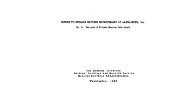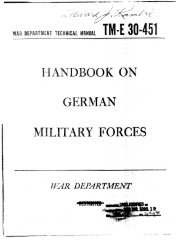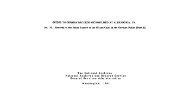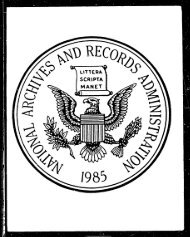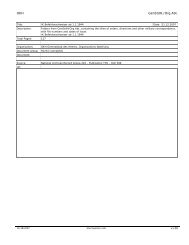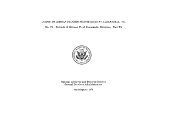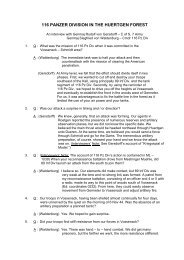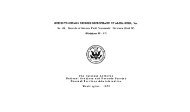The Poliere and Schachtmeister became, during the workinghours, the nucleus of the irreducible minimum of GermanNCO supervisory personnel over foreign manpower. Controlduring working hours, therefore, remained entirely German,The problem of obtaining sufficient German Poliere wasmet by lowering the requirement standards to the pointwhere the designation 'Polier 1 no longer guaranteed aminimum of skill and experience; by the selection ofelderly men including septuagenarians; by giving thePoliere assistants in the form of foreign 'Hilfs poliere 1(Assistant Foremen), see para.118, vi. below. ThePolier, in turn, was also called upon to assume semeresponsibilities in camp in addition to his normalresponsibility on the construction Job.ii.Foreigners were deputised to positions of trust andresponsibility in the camp, usually over groups of theirown countrymen. Final control, however, rested withGerman personnel. Lagerftthrer (camp supervisors), forexample, formed the nucleus of German control in theCamp. Even in their case, though rarely, collaborationistscame to be entrusted in 1944 with the running ofcamps. Those instances, relatively few in number, cameabout through the insistence of Ant Bau-OTZ, which, inits efforts to obtain effective foreign collaboration inoccupied Europe, had embarked on a conciliatory policy.This policy generally met opposition from local OTofficials and in the last analysis was effectivelysabotaged by German personnel in the various camps.Hilfslagerfuhrer (Assistant Camp Supervisors), on theother hand, tvere all foreigners. Incidentally, many ofthe Hilfslagerfubrer also acted as Assistant Foremenduring working hours on the construction job.iii.Inasmuch as the main part of the above-mentioned reorganisation(March 1944) in personnel administration,involved the transfer of a good deal of responsibilityin this respect from the QBL Frontfuhrung to theindividual OT-firms operating within the OBL sector, anew post was created within each OT-firm to take thisresponsibility. The post is that of Mannschaftsftthrer(OT-firm personnel officer), and is discussed below(para.118, iii) .118. The New Chain of Comnand in the Supervision of Labour.The effect of the re-arrangement of personnel administrationin the spring of 1944 was to make the OT-f irm, for all practicalpurposes, a self-contained operational unit, and as such a lowerechelon of the QBL. The OT-f irm remained essentially statio withinthe limits of its operational sector (at least such was the hopeof the higher administration). Yet inasmuch as relations betweenfirm personnel ami worker detachaents had be<strong>com</strong>e closely integrated,the OT-f irm was capable of reverting to a mobile status on startorder. The characteristic of the new arrangement was the investmentof one individual with dual and even triple functions with correspondinglydual or even triple responsibility, a characteristicalready familiar to us in German political and military organisationsas a whole. The new chain of <strong>com</strong>mand in the supervision oflabour, as a result of these modifications in the spring of 1944,is as follows:£. The Einheitsfdhrer (Firm Executive) is responsible to theOberpauleiter ancTto the Frontftihrer, to the first in mattersconcerning construction, to the second in matters concerningpersonnel.-124
ii . Betriebsftihrer (Finn Manager). Now that the firm has apersonnel administration of its own, it has be<strong>com</strong>e ineffect a lower echelon of the CBL administration. Theneed, therefore, arose for a conmanding officer responsiblein this respect to the QBL HQ. The Firm Manager,a post usually filled by the Firm Executive himself, wasconsequently invested with this new responsibility.Under this arrangement, the Mannschaftsfuhrer (see iii.below) is personnel administrator, but final responsibilityrests with tha Betriebsftihrer.iii . Einheitsmannschaftsfuhrer or Mannschaftsftthrer. (OT-firwPersonnel Officer). ThTMannschaftsftthrer i s the Frontftthrerof the firm. Ke is especially concerned with theGerman personnel, care of the foreign workers being entrustedto the Kilfspoliere (see vi.). He is eitherassigned to the firm by the OBL or selected by the firmfrom among its own personnel. In the latter case, heundergoes schooling in respect to Frontftthrung duties(see IIIC130) before being accepted by the CBL. In theformer case he is made a member of the f Stammannschaft'of the farm (see Table I, No.12), although his servicestatus remains that of OT-organic personnel. As aFrontftXhrer he also has the rank of Betriebsobmann in theDeutsche Arbeitsfront (DAF: German Labour Front) and assuch represents the PAF's interests in the OT. Hisoffice is located on the construction site rather thanin the camp. Computation of expenses incurred by him forthe welfare of the men in his charge is made according toinstructions issued by the Vertragsabteilung (ContractsSection) of the EG. His principal duties include theeducation of the Frontarbeiter in respect to Nazi ideology,to discipline, fellowship, air-raids, gas and fireprotection,guard duty and functions of the SK; advice onquestions of pay, tariffs, furlough; control of Dienstbuch(pay and Identity Book) and identification discs; aid incase of accident, death, personal problems; improvementof billeting ac<strong>com</strong>modations; distribution of rations andsupervision of their preparation; rationing of canteenarticles; maintenance of equipment; assignment of detailsand regulation of leisure time; library administration,distribution of newspapers and magazines; indoctrinationof German personnel in the proper employment of foreignworkers according to OT regulations in respect to raceand nationality discrimination. The routine duties of hisoffice are divided amongst (1) the Poliere, in regard toGerman personnel with the exception of the clerical staff,2) the Senior Clerk, in regard to the clerical staff,! 3) the Hilfspoliere, in regard to the foreign workers.iv. Oberpoliere (and Oberschachtmeister). The Oberpolier isa senior foreman on Jobs employing two or more foremenand reports directly to the Bauleiter (ConstructionSupervisor) much the same as a ranking NCO in the armyreports to his CO.v. Polier (and Schachtmeister) (Foremen; only the personneladministration assignment of Polier and Schachtraeisteris discussed here. Their assignment -as labour gangforemen is discussed below in para.U9). The Polier(and Schachtmeister) is deputised to perform basicadministrative duties of the Mannschaftsfuhrer. Ineffect, the Polier and Hilfspolier (see vi.) between themtake over most of the routine administration from theMannschaftsfuhrer, and leave to the latter only the-125
- Page 1 and 2:
IR5/f!lR-0T/5/4SHRnDBOOK OF THEDRcn
- Page 3 and 4:
GE R MAN YOT EINSATZGRUPPEN, AUTUMN
- Page 5 and 6:
TABLE OP CONTENTS(See also LIST OP
- Page 7 and 8:
4a. OrganizSferiy %f Sfciw t>T& ^ ^
- Page 9 and 10:
Page35. "Current Organization" Eins
- Page 11 and 12:
155» Miscellaneous Deductions and
- Page 13 and 14:
To-day PT is indispensable in any p
- Page 15 and 16:
UNCLASS13* The two "basic types 6_
- Page 17 and 18:
of control over its plans, which we
- Page 19 and 20:
OT units was that of Bautrupps (Con
- Page 21 and 22:
__ n be committed to work by order
- Page 23 and 24:
11. OT Construction Activities 1942
- Page 25 and 26:
In case of Allied landings. In the
- Page 27 and 28:
Factors militating against complete
- Page 29 and 30:
1* Rationalization^ on a nation wid
- Page 31 and 32:
The project itself cannot be accept
- Page 33 and 34:
areas within the Reich; (3) Einsatz
- Page 35 and 36:
has the final responsibility for me
- Page 37 and 38:
Matters of policy, as decided upon
- Page 39 and 40:
with the Wehrmacht and with civil a
- Page 41 and 42:
which do the actual work. This is o
- Page 43 and 44:
adjacent construction sites are gro
- Page 45 and 46:
Amt Bau-OTZ.The second ia the auton
- Page 47 and 48:
are to be employed in tha execution
- Page 49 and 50:
"Current Organization" Bauleitung (
- Page 51 and 52:
Former Hauptabteilungen in OTZ have
- Page 53 and 54:
(SS Liaison Officer) are the follow
- Page 55 and 56:
y the Array for the construction of
- Page 57 and 58:
fortresses stretch over its entire
- Page 59 and 60:
(Eastern Wall) in April 1943* At on
- Page 61 and 62:
obviously would also have the same
- Page 63 and 64:
Consequently ten lype A emplacement
- Page 65 and 66:
at the expense of the "private comm
- Page 67 and 68:
eside those of feeding and billetin
- Page 69 and 70:
57* Construction Programme, Materia
- Page 71 and 72:
Italian firms arid the workers is c
- Page 73 and 74:
"The large scale construction work
- Page 75 and 76:
Diplom - Ingenieur "* Paul ANDORY,
- Page 77 and 78:
Para. 7 ~ CompensationCompensation
- Page 79 and 80:
Para* 16 - Text of the ContractThe
- Page 81 and 82:
m tag » * u »"5. For ascertaining
- Page 83 and 84:
- Delivery of Building MaterialThe
- Page 85 and 86: prior consent of the HU. Any assign
- Page 87 and 88: ecause of Allied propaganda and the
- Page 89 and 90: all replacement parts of machine we
- Page 91 and 92: served only as a general directive.
- Page 93 and 94: The transport organizations forking
- Page 95 and 96: outside the "boundaries of the Reic
- Page 97 and 98: d) Health and Medical Services77. M
- Page 99 and 100: tfhTheading "identifying scars or w
- Page 101 and 102: example, units of the Feldgendanaer
- Page 103 and 104: set up within the region of each Ar
- Page 105 and 106: Sc^al Festungspionier stab, (Portre
- Page 107 and 108: Refer at (Sub Unit) BII1 : Hochbau,
- Page 109 and 110: 2. Although the agencies are subord
- Page 111 and 112: Emergency Measures1. In case of imm
- Page 113 and 114: The interests of the OT firms as an
- Page 115 and 116: of the OBL cuts across two or more
- Page 117 and 118: The following captured document, he
- Page 119 and 120: sche Nothilfe - Technical Tanarfien
- Page 121 and 122: Chef de¥iflitfSItverwaltung, Haupt
- Page 123 and 124: corresponding in area to the DHL's.
- Page 125 and 126: ij Feldpoli^ei (commonly abbreviate
- Page 127 and 128: erNSKK Verbindungsf&hrer des Transp
- Page 129 and 130: , _ .-^^-^^-^sson of aDienstbuch (P
- Page 131 and 132: ar T—all phases of OT operation.
- Page 133 and 134: B. Classicioation of Personnela) Ge
- Page 135: Control during working hours - unde
- Page 139 and 140: vii,obhoer*ed. In the performance o
- Page 141 and 142: were supposed to b« numbered conse
- Page 143 and 144: In the autumn of 192*4, co-operatio
- Page 145 and 146: with the French Betreuungftthrer me
- Page 147 and 148: C; Training.129. Military Training.
- Page 149 and 150: Russians also received this trainin
- Page 151 and 152: NCO in OT - Dienst Unifom wearing M
- Page 153 and 154: only distinguishing feature being t
- Page 155 and 156: Dr. Pritz Todt Ehrennadel in Gold (
- Page 157 and 158: ff f^f(b) * OT-Eigenes Personal (OT
- Page 159 and 160: (v)the same*In December 1944, howev
- Page 161 and 162: "IT "BT •CTGefcaltsgruppe I. 2 On
- Page 163 and 164: untranslated and may be checked in
- Page 165 and 166: Up to this point OT tariffs affecti
- Page 167 and 168: a|t|jr^|| h l^fcers are paid accord
- Page 169 and 170: ftfonthlv Einsatz Pav forMarried Wo
- Page 171 and 172: IpecTaj regulations affecting OT pa
- Page 173 and 174: or.- soid(Wehrsold) G. Gouv. Russ
- Page 175 and 176: or negligence:time lost because of
- Page 177 and 178: ^rfrom service in the OT, the worke
- Page 179 and 180: MANPOWERA. General Manpower Statist
- Page 181 and 182: 162. FirmenangehgrJRe (OT»-Firm Pe
- Page 183 and 184: x» , ~«^«u u*^ of 1942, irregula
- Page 185 and 186: The nuSKF'Wf s&lfeifrms 1 is estima
- Page 187 and 188:
equally urgent rSeP^^irniShing Germ
- Page 189 and 190:
Orders had come through to class ev
- Page 191 and 192:
The Gorman Feldkommandanturen who w
- Page 193 and 194:
Baltic Manpower179* Proportion and
- Page 195:
and to a lesser_. —ii«i4lfiU&»




